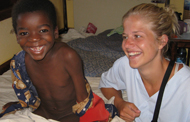Intensivkurs i Savolinna, Nyslott
2015-10-10
Det började med att våra lärare la upp en inbjudan om att åka till Nyslott i Finland. Nyslott kallas av finnarna för Savolinna. Savolinna är en stad som är ungefär så stor som Kalmar och är lik Kalmar lite svårare tillgänglig att resa till med kollektivtrafiken. Nyslott har även ett slott som är ungefär lika gammal som Kalmar slott och byggdes också i etapper genom århundraden. Det var faktiskt en gång i tiden svensk. Så mycket likheter med Kalmar.
Det var inte så att jag var intresserad av att åka till Finland först, jag hade mycket att göra i skolan, men sedan dök det upp ytterligare ett mail på nätet då en klasskompis ville åka och sa att det fortfarande behövs 2 personer till för att åka. Då jag frågade en annan klasskompis och på kort varsel bestämde vi oss för att åka med till Finland. Eftersom ingen annan ville åka var detta perfekta sättet att se en del av Europa jag inte hade sett tidigare och komma bort lite från Kalmar och se andra sjuksköterskestudenter!
Vi packade våra väskor och åkte med tåget till Köpenhamn. En lärare från Linneuniversitetet skulle följa med vård resa. Det blev Kristiina Heikkilä som faktiskt ursprungligen är från Finland. Det visade sig vara rätt hjälpsam då Kristiina visste en hel del om Finland som hjälpte oss att få mer ut av vår resa.
Meningen med resan var att tillsammans med andra studenter från Norge, Danmark och Finland diskutera och arbeta med teknologi inom vården, kort och gott, robotar.
Från Köpenhamn flög vi till Helsingfors och tog sedan en hyrbil från flygplatsen till Nyslott.
Finland är ett land som är del i EU och som på många sätt har kommit länge i arbetet med vården än Sverige. Vi fick reda på att det arbetas med en teknologisk dosa som heter “Mirella”. Mirella kan ställas in för olika sorteras behov i hemmet hos människor med behov av hjälp som lever ute på landet där det inte alltid är så lätt att leverera god vård. Mirella kan läsa av temperaturskillnader i en lägenhet, luftfuktighet, den kan anslutas till sändare i säng och matta bredvid sängen – allt för att på ett kontor kunna se hur personen har det i hemmet. Vi diskuterade både för- och nackdelar med teknologin, men sammanfattningsvis kom vi fram till att nya sätt kommer att behövas i framtiden då behovet av vård- och omsorg håller på att ökas och kommer fortsätta att öka med tiden då fler människor blir äldre och vårdpersonalen redan idag inte räcker till.
Det var mycket spännande att se en annan del av Skandinavien, en del som är till stor del influerad av öststaterna. Vi hann tyvärr aldrig titta på Helsinki (Helsingfors), men det får helt enkelt bli en annan gång. Jag hade turen att kunna grilla marshmallows med de finsak och danska studenterna och fick på vägen hem se denna fantastiska vy:

Som avslutning bjöd skolan på spa på hotellet bredvid studentlägenheterna vi fick bo i under vistelsen. Där passade några finska studenter och ja på att bada iskallt i sjön efter en äkta finsk bastu.
Resan till Nyslott gjorde oss 3 hp rikare i våra betyg och blev betalt av samfundet Nordplus. De organisera var fjärde år en resa till en av de 4 universitet som arbetar tillsammans från Norge, Sverige, Danmark och Finland.
Typisk finsk: lakritsi. Här på en glass.











 När man läser till sjuksköterska på Linnéuniversitetet kan man göra en del av sin utbildning i ett annat land. De studenter som har valt att göra det delar med sig sina erfarenheter i den här bloggen.
När man läser till sjuksköterska på Linnéuniversitetet kan man göra en del av sin utbildning i ett annat land. De studenter som har valt att göra det delar med sig sina erfarenheter i den här bloggen.